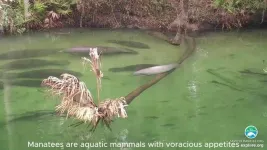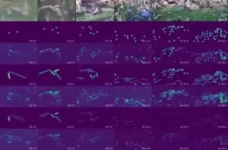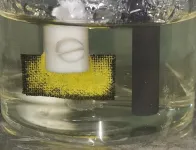Accurately counting manatee aggregations within a region is not only biologically meaningful in observing their habit, but also crucial for designing safety rules for boaters and divers as well as scheduling nursing, intervention, and other plans. Nevertheless, counting manatees is challenging.
Because manatees tend to live in herds, they often block each other when viewed from the surface. As a result, small manatees are likely to be partially or completely blocked from view. In addition, water reflections tend to make manatees invisible, and they also can be mistaken for other objects such as rocks and branches.
While aerial survey data are used in some regions to count manatees, this method is time-consuming and costly, and the accuracy depends on factors such as observer bias, weather conditions and time of day. Moreover, it is crucial to have a low-cost method that provides a real-time count to alert ecologists of threats early to enable them to act proactively to protect manatees.
Artificial intelligence is used in a wide spectrum of fields, and now, researchers from Florida Atlantic University’s College of Engineering and Computer Science have harnessed its powers to help save the beloved manatee. They are among the first to use a deep learning-based crowd counting approach to automatically count the number of manatees in a designated region, using images captured from CCTV cameras, which are readily available, as input.
This pioneering study, published Scientific Reports, not only addresses the technical challenges of counting in complex outdoor environments but also offers potential ways to aid endangered species.
To determine manatee densities and calculate their numbers, researchers used generic images captured from surveillance videos from the water surface. They then used a unique design matching to manatees’ shape – Anisotropic Gaussian Kernel (AGK) – to transform the images into manatee customized density maps, representing manatees’ unique body shapes.
Although many methods exist for counting, most of the existing counting methods are applied to crowds to count the number of people, due to their relevance to important applications such as urban planning and public safety.
To save labeling costs, researchers used line-label based annotation with a single straight line to mark each manatee. The goal of the study was to learn to count the number of objects within a scene and obtain labels to support counting.
Results of the study reveal that the FAU-developed method outperformed other baselines, including the traditional Gaussian kernel-based approach. Transitioning from dot to line labeling also improved wheat head counting accuracy, an important role in crop yield estimation, suggesting broader applications for convex-shaped objects in diverse contexts. This approach worked particularly well when the image had a high density of manatees in a complicated background.
By formatting manatee counting as a deep neural network density estimation learning task, this approach balanced the labeling costs vs. counting efficiency. As a result, this method delivers a simple and high throughput solution for manatee counting that requires very little labeling efforts. A direct impact is that state parks can leverage this method to understand the number of manatees in different regions, by using their existing CCTV cameras, in real time.
“There are many ways to use computational methods to help save endangered species, such as detecting the presence of the species and counting them to collect information about numbers and density,” said Xingquan (Hill) Zhu, Ph.D., senior author, an IEEE Fellow and a professor in FAU’s Department of Electrical Engineering and Computer Science. “Our method considered distortions caused by the perspective between the water space and the image plane. Since the shape of the manatee is closer to an ellipse than a circle, we used AGK to best represent the manatee contour and estimate manatee density in the scene. This allows density map to be more accurate, in terms of mean absolute errors and root mean square error, than other alternatives in estimating manatees’ numbers.”
To validate their method and facilitate further research in this domain, the researchers developed a comprehensive manatee counting dataset, along with their source code, published through GitHub for public access at github.com/yeyimilk/deep-learning-for-manatee-counting.
“Manatees are one of the wildlife species being affected by human-related threats. Therefore, calculating their numbers and gathering patterns in real time is vital for understanding their population dynamics,” said Stella Batalama, Ph.D., dean, FAU College of Engineering and Computer Science. “The methodology developed by professor Zhu and our graduate students provides a promising trajectory for broader applications, especially for convex-shaped objects, to improve counting techniques that may foretell better ecological results from management decisions.”
Manatees can be found from Brazil to Florida and all the way around the Caribbean islands. Some species including the Florida Manatee are considered endangered by the International Union for Conservation of Nature.
Study co-authors are FAU graduate students Zhiqiang Wang; Yiran Pang; and Cihan Ulus, also a teaching assistant, all within the Department of Electrical Engineering and Computer Science.
The research was sponsored by the United States National Science Foundation.
- FAU -
About FAU’s College of Engineering and Computer Science:
The FAU College of Engineering and Computer Science is internationally recognized for cutting-edge research and education in the areas of computer science and artificial intelligence (AI), computer engineering, electrical engineering, biomedical engineering, civil, environmental and geomatics engineering, mechanical engineering, and ocean engineering. Research conducted by the faculty and their teams expose students to technology innovations that push the current state-of-the art of the disciplines. The College research efforts are supported by the National Science Foundation (NSF), the National Institutes of Health (NIH), the Department of Defense (DOD), the Department of Transportation (DOT), the Department of Education (DOEd), the State of Florida, and industry. The FAU College of Engineering and Computer Science offers degrees with a modern twist that bear specializations in areas of national priority such as AI, cybersecurity, internet-of-things, transportation and supply chain management, and data science. New degree programs include Master of Science in AI (first in Florida), Master of Science and Bachelor in Data Science and Analytics, and the new Professional Master of Science and Ph.D. in computer science for working professionals. For more information about the College, please visit eng.fau.edu.
About Florida Atlantic University:
Florida Atlantic University, established in 1961, officially opened its doors in 1964 as the fifth public university in Florida. Today, the University serves more than 30,000 undergraduate and graduate students across six campuses located along the southeast Florida coast. In recent years, the University has doubled its research expenditures and outpaced its peers in student achievement rates. Through the coexistence of access and excellence, FAU embodies an innovative model where traditional achievement gaps vanish. FAU is designated a Hispanic-serving institution, ranked as a top public university by U.S. News & World Report and a High Research Activity institution by the Carnegie Foundation for the Advancement of Teaching. For more information, visit www.fau.edu.
END









